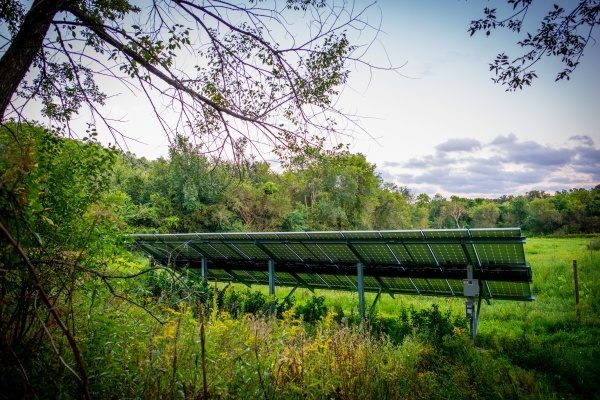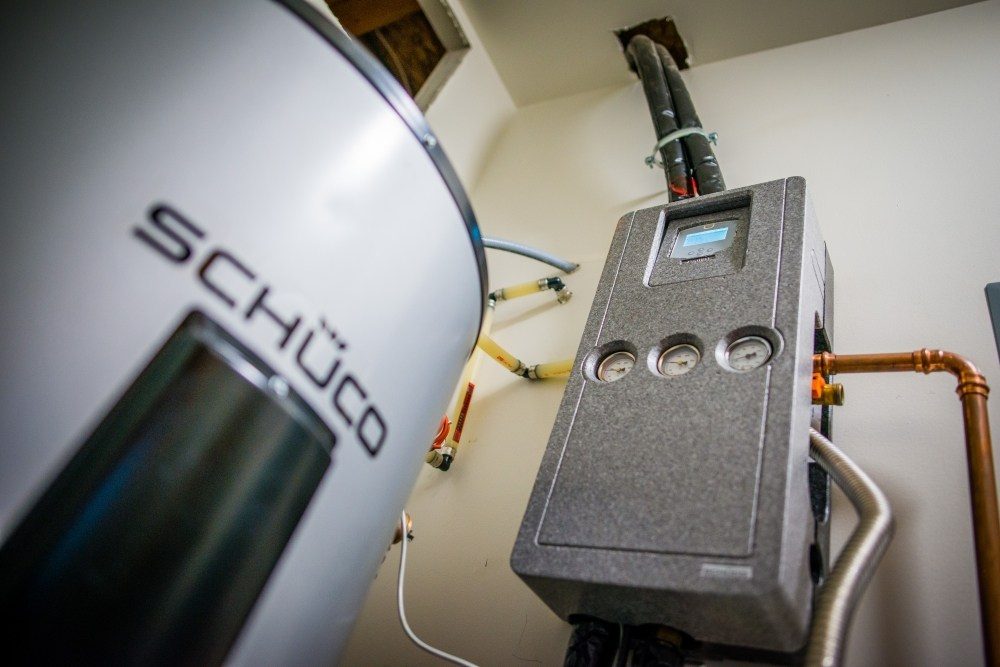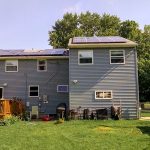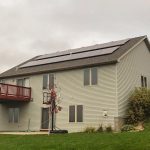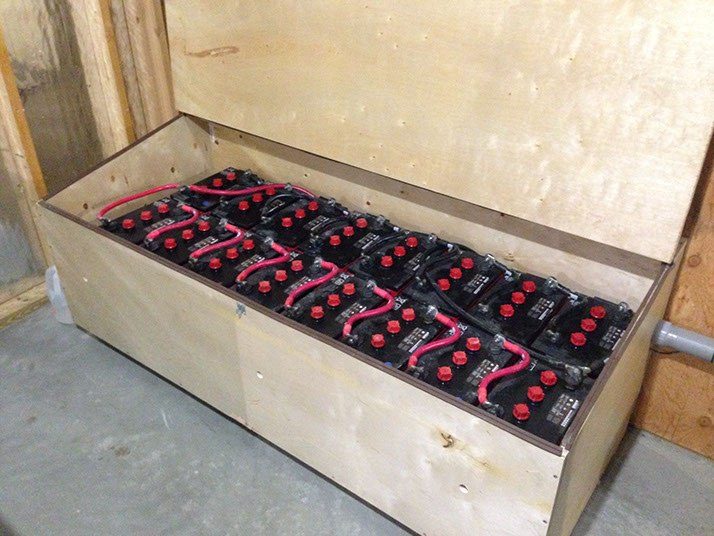
Off-Grid & Battery Back-up: What you need to know
In almost all cases, it makes sense economically and environmentally to tie your solar array to the electrical grid. This allows you cheap or free access to energy at night, and allows other electrical customers to make use of the excess clean energy you produce during the day. But there are circumstances where going off-grid is the right move: if you are building in an area so remote that you can’t reach an electric utility, or if energy for equipment (like medical devices or sump pumps) can’t be compromised. (A zombie apocalypse is another situation where off-grid energy production would be desirable, but that scenario deserves an article of its own.)
Most people don’t realize that, though solar panels can produce energy any time they are in sun, the solar inverter—the equipment that feeds the energy into your home—is designed by law to shut down in grid-tied systems in the case of a power outage, and for good reason. Solar energy feeding into the grid while linemen are repairing wires could result in serious injury or even death.
Keeping the lights on (and the sump-pump running) is made possible through backup battery systems, generators, or a combination of the two. But first, you have to decide how much energy you really need.
Becoming an energy minimalist
Whether on or off the grid, the key to affordable energy storage is to become an energy minimalist. The average American lifestyle consumes a lot of energy use for convenience and even more for comfort. A portion of energy use is literally wasted—used on things you didn’t realize were pulling energy in the first place.
Our first step when talking to back-up or off-grid clients is to help them hone in on what they need. This often comes down to major appliances like the sump pump, well pump and refrigerator, as well as lighting in the main living area. By collecting the wattages of each appliances and estimating how long they run, we can calculate with surprising accuracy how much energy storage will be needed to keep a system running for two, six, twelve or twenty-four hours.
Good daily off-grid power consumption should fall around 5-10 kilowatt-hours (kWh); the average Minnesota home would use 25 kWh during the same period. Many people are surprised at how little they miss the extra electricity. Since they understand how to use their energy and have energy-efficient appliances and lighting, our off-grid customers are happy and comfortable with all their needs met.
The circuits that will pull on the energy storage are rewired to a separate “critical loads” panel, which is then hooked up to either a battery bank, a generator, or both.
Battery banks
Having a battery backup system for your solar array means that homeowners can have power 24/7 in almost any conditions. Home batteries fall into three categories: flooded, maintenance-free and the increasingly popular lithium-ion.
Flooded batteries
Flooded batteries—so called because they must be occasionally refilled with water—are currently the best option for fully off-grid applications because of their longevity. How long a battery will last depends on how often it is discharged; while a no-maintenance battery bank will last around 1,500 discharges, flooded batteries will maintain sufficient capacity for as many as 4,500 discharges. This means that, depending on conditions, fully off-grid batteries recharged daily by solar can last for six to twelve years. For the extra-prepared, there are extra-thick leaded batteries that can last as many as 20 years. The up-front cost for these high performance batteries is about double that of regular flooded varieties, but because of their lifespan, the per-day cost is almost equivalent.
Because they are not fully sealed, flooded batteries leak small amounts of gases and must be kept in a well-ventilated space.
No-maintenance batteries
Despite their heartiness, the down-side to flooded batteries is that they require tinkering. Real battery geeks will check the acidity of the battery and even the specific gravity at their location to determine the maintenance routine, called an “equalization.” No-maintenance batteries are fully sealed, so no gases escape and no equalization is required. Since they are usually intended as backup in case of power outages, their 1,500-cycle lifespan would last for decades.
The key concern for battery backup systems is how long the owner wants to be able to function without power generation, which is measured in “days of autonomy.” Most power outages last less than two hours, so __ batteries would be sufficient. The system could be sized to fully charge during the day and fully discharge at night (one day of autonomy), but because cloudy or snowy days would interrupt the system, more robust systems may aim for 1.5 days of autonomy.
Lithium-Ion batteries
Lithium-ion batteries, recently popularized by car and battery manufacturer Tesla, have notable advantages over traditional lead-acid batteries. They require no maintenance but will last for twice as many cycles as a flooded battery. They can also be fully discharged in each cycle, unlike lead-acid batteries, which are damaged if discharged below 50%. In the end, that means half as many batteries are needed in the battery bank. Construction of the lithium-ion battery Giga Factory in Nevada will further drop costs, and it’s anticipated that lithium-ion will replace flooded batteries before long.
But before you get too excited, even the Tesla Powerwall doesn’t have the capacity to take a home off grid economically. Powerwalls were designed in the expectation that soon areas like California and Arizona, which are becoming increasingly solar saturated, would no longer be able to sell their energy back to the grid. An efficient in-home battery would allow a home to capture some of the extra energy produced during the day to use at night, but likely not enough to sustain the home indefinitely unless the household is able to dramatically reduce its power use. At their current capacity, Powerwalls could cover perhaps 25% of the daily load in Minnesota.
Battery Cost
The cost of a battery bank can be manipulated by powering vital appliances like sump pumps and refrigerators. Individual batteries cost hundreds of dollars, so the cost of equipment, rewiring and installation for a generously-sized system could come to $15,000. On the other end of the spectrum, one Solar Connection customer needed only a single battery to backup an off-grid cabin where the family had gotten by with a light wired to a car battery for 20 years of weekend visits.
Generators
Generators are a more powerful energy backup system, and thus the best solution in situations where the power simply cannot be compromised. Generators are mainstays at hospitals, manufacturing plants and more.
Whereas batteries can recharge with solar, generators burn fuel. This can come from a natural gas line, an on-site propane tank or a gas can. (Be sure to get fresh gas occasionally, as gasoline becomes uncombustable over time.)
A decently sized generator system—equipment and installation—usually starts at about $10,000, and fluctuates based on the circuits connected to the critical loads panel and the site layout.
Small generators also make great compliments to solar battery backup systems. They make it possible to install a smaller (and thus less expensive system), knowing that the generator can recharge the batteries if the weather refuses to cooperate for an extended period.
